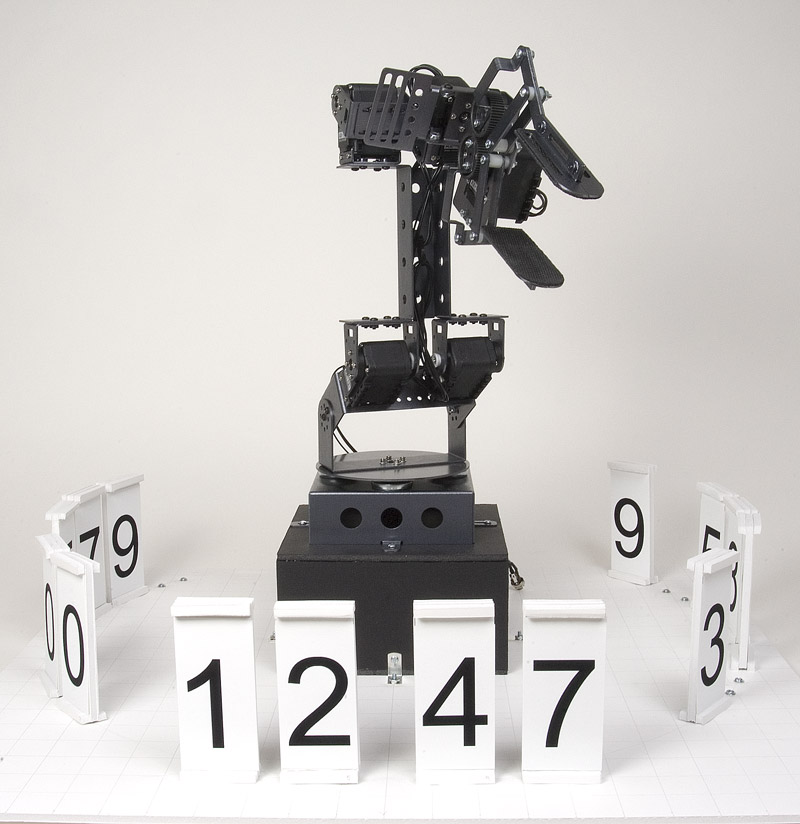Stonehenge - A Robotic Digital Clock
Stonehenge is my latest and most certainly my most unusual robot project to date. It uses a CrustCrawler AX-12+ Smart Arm and a Parallax Propeller chip to display the current time. All the digits needed to display the time are located on cards positioned in a semi-circle around the left and right sides of the arm. The time itself is displayed in front of the arm. This gives the clock a "Stonehenge" like appearance. There are a total of 14 cards. Each card has two digits with one on each side.
·
A state machine (written in Spin) determines which card and which side is needed to display the time and then executes the necessary arm movements. It updates the time once a minute. Currently it displays the time in 12 hour format. With additional cards it’s possible to display an AM/PM indicator or use 24 hour format.·
·
Most of the project was constructed from foam board purchased from the local office supply store. The cards are 1 ¾ by 4 inches. Embedded in the bottom of each card are two Neodymium magnets. The magnets snap to heads of 4-40 screws that are mounted in the base. The magnet/screw scheme compensates for any small amount of error that inevitably occurs when gripping and moving the cards around.
·
I’ve posted a short video of Stonehenge in action on YouTube.
·
http://www.youtube.com/watch?v=pH0HLXnXljY
·
The video shows a time update from 12:09 to 12:10. It demonstrates all the basic movements needed to display the time. If you watch carefully you can see it execute the following movements.
·
Put Card in Display
Get Card from Display
Put Card in Storage
Get Card from Storage
Flip Card around
·
I’ll also post more details and source code for those that are interested on my web site shortly.
www.norrislabs.com
·
·
▔▔▔▔▔▔▔▔▔▔▔▔▔▔▔▔▔▔▔▔▔▔▔▔
The angels have the phone box!
Steve Norris
·
A state machine (written in Spin) determines which card and which side is needed to display the time and then executes the necessary arm movements. It updates the time once a minute. Currently it displays the time in 12 hour format. With additional cards it’s possible to display an AM/PM indicator or use 24 hour format.·
·
Most of the project was constructed from foam board purchased from the local office supply store. The cards are 1 ¾ by 4 inches. Embedded in the bottom of each card are two Neodymium magnets. The magnets snap to heads of 4-40 screws that are mounted in the base. The magnet/screw scheme compensates for any small amount of error that inevitably occurs when gripping and moving the cards around.
·
I’ve posted a short video of Stonehenge in action on YouTube.
·
http://www.youtube.com/watch?v=pH0HLXnXljY
·
The video shows a time update from 12:09 to 12:10. It demonstrates all the basic movements needed to display the time. If you watch carefully you can see it execute the following movements.
·
Put Card in Display
Get Card from Display
Put Card in Storage
Get Card from Storage
Flip Card around
·
I’ll also post more details and source code for those that are interested on my web site shortly.
www.norrislabs.com
·
·
▔▔▔▔▔▔▔▔▔▔▔▔▔▔▔▔▔▔▔▔▔▔▔▔
The angels have the phone box!
Steve Norris




Comments
▔▔▔▔▔▔▔▔▔▔▔▔▔▔▔▔▔▔▔▔▔▔▔▔
I am 1011, so be surprised!
Advertisement sponsored by dfletch:
Come and join us on the Propeller IRC channel for fast and easy help!
Channel: #propeller
Server: irc.freenode.net or freenode.net
If you don't want to bother installing an IRC client, use Mibbit. www.mibbit.com
▔▔▔▔▔▔▔▔▔▔▔▔▔▔▔▔▔▔▔▔▔▔▔▔
Searider
Good use of the magnets too!
▔▔▔▔▔▔▔▔▔▔▔▔▔▔▔▔▔▔▔▔▔▔▔▔
Timothy D. Swieter
www.brilldea.com·- check out the uOLED-IOC, an I/O expansion for the uOLED-96-PROP
www.tdswieter.com
One little spark of imagination is all it takes for an idea to explode